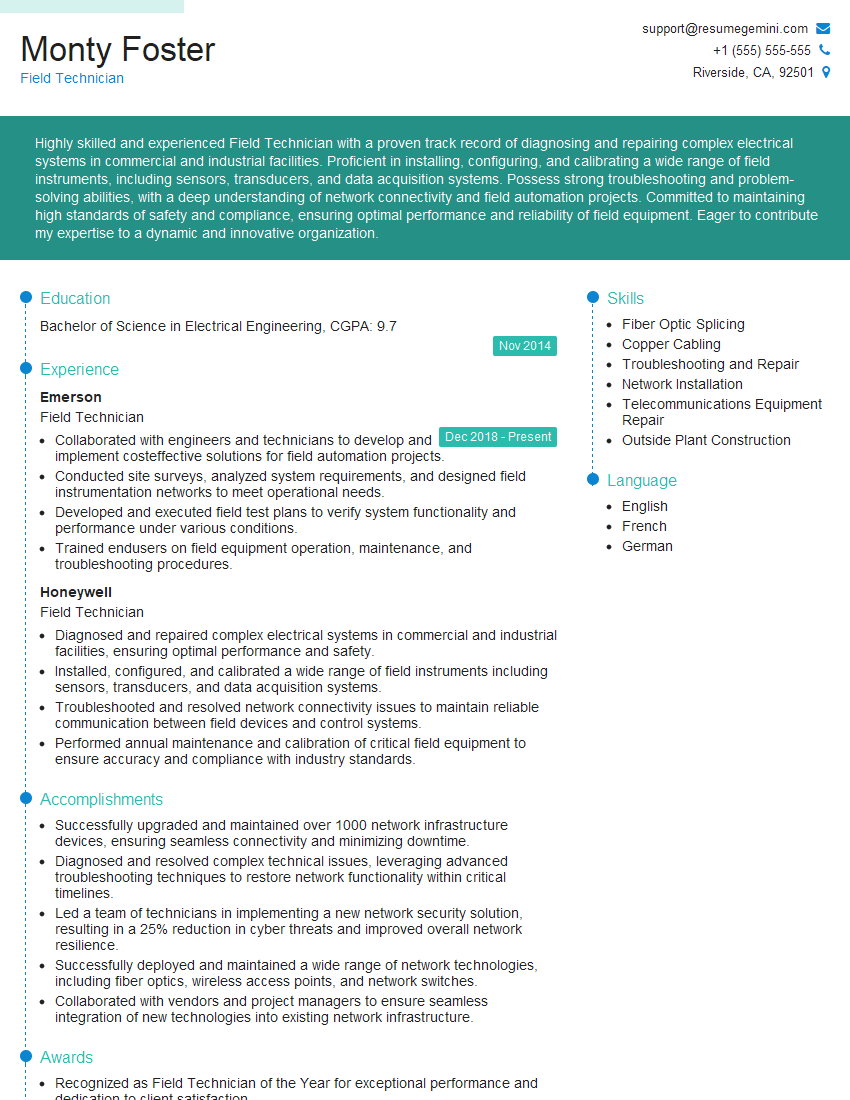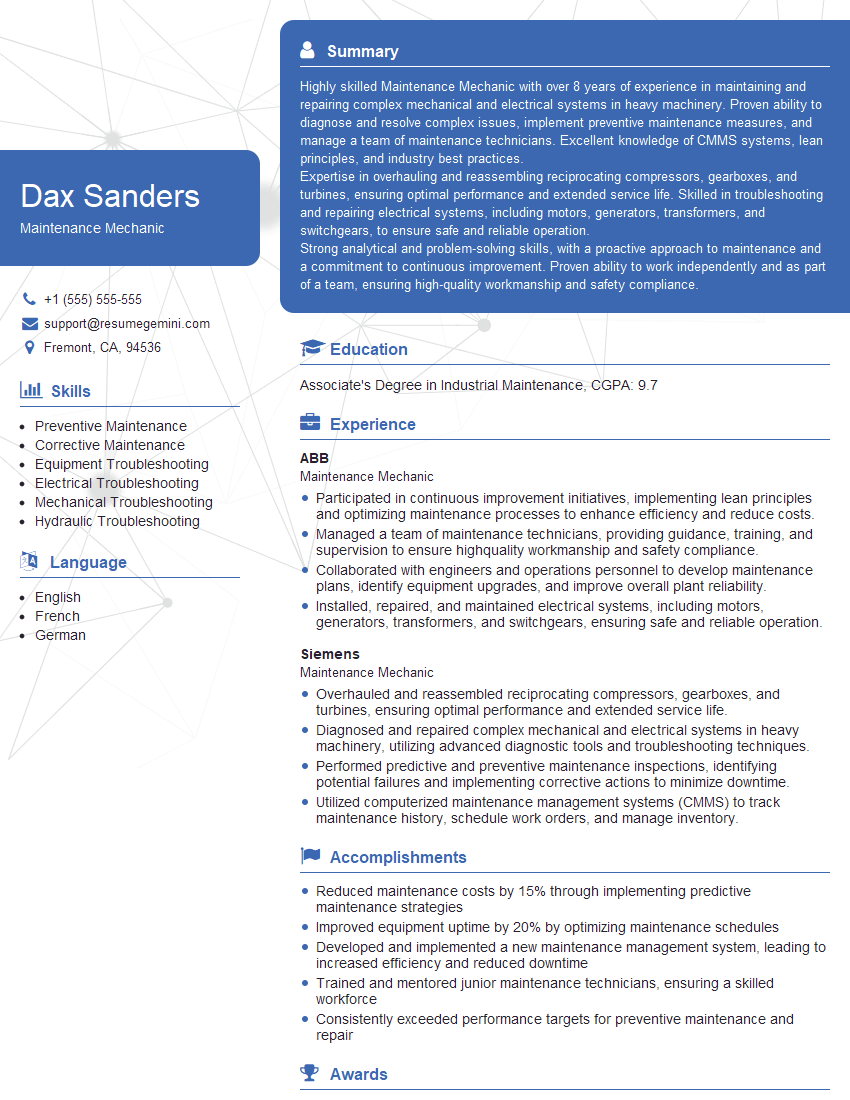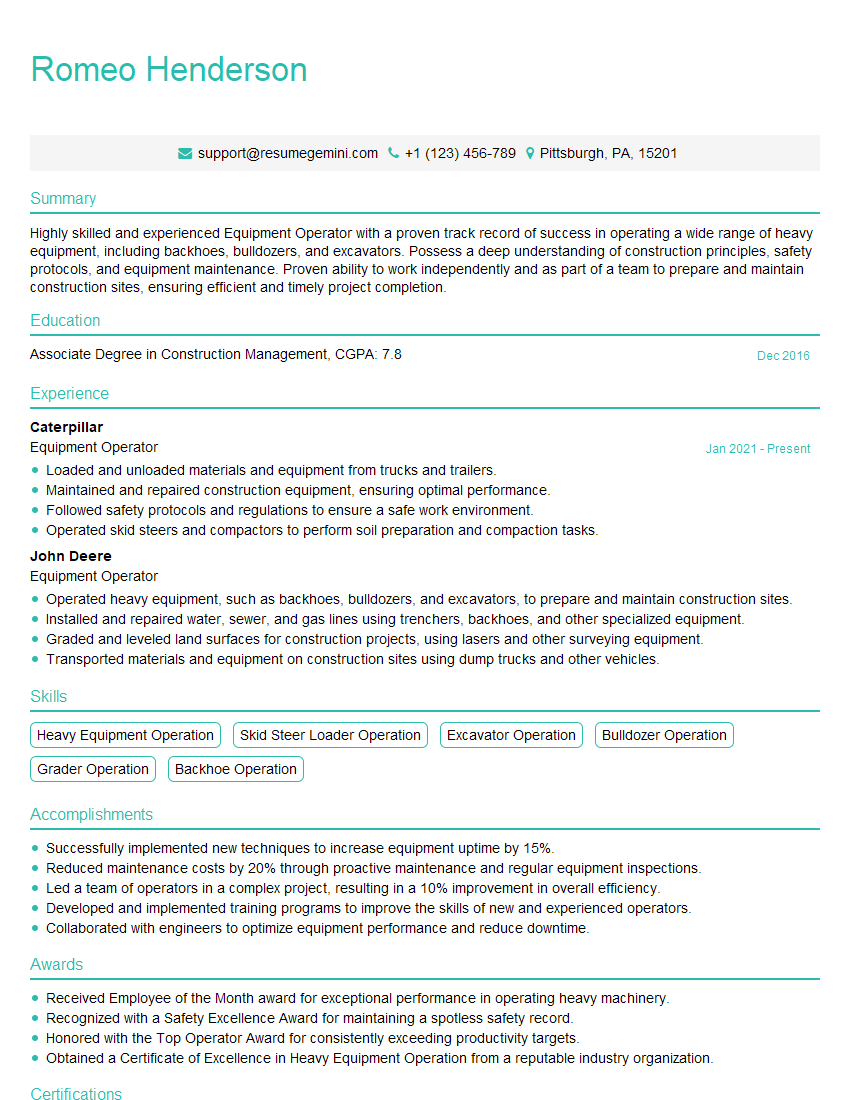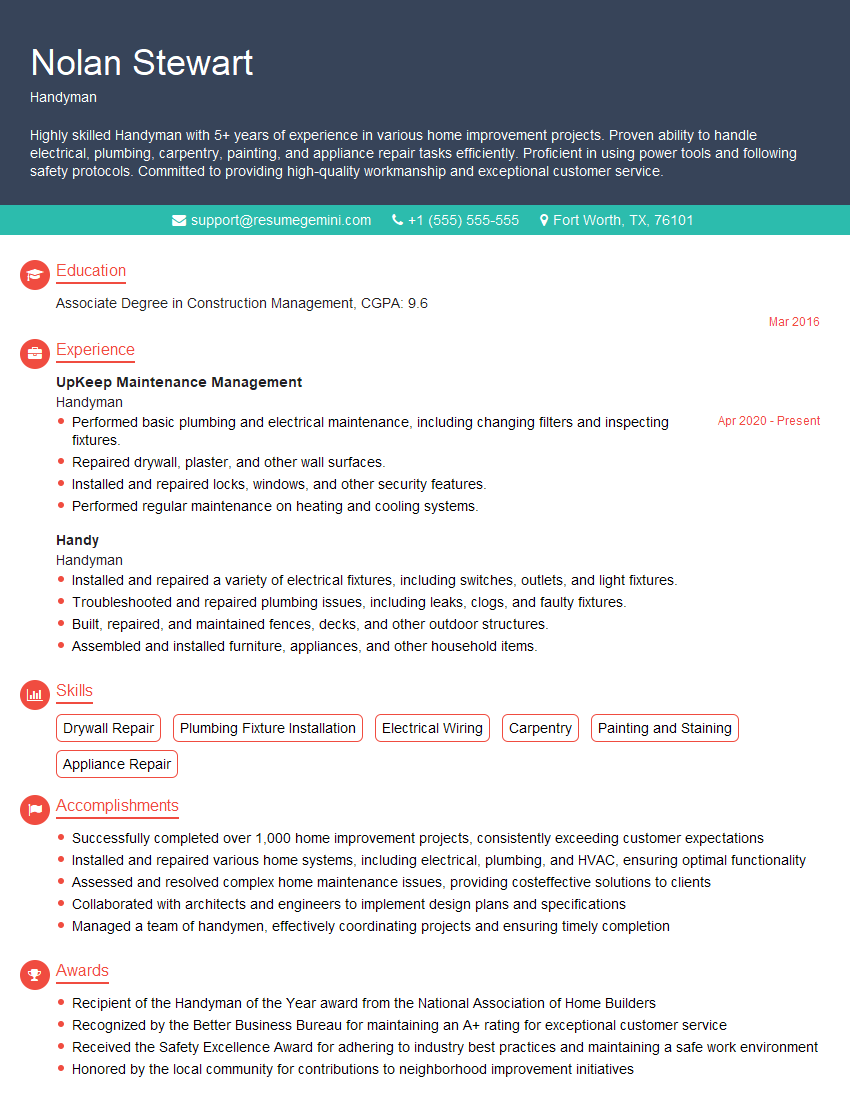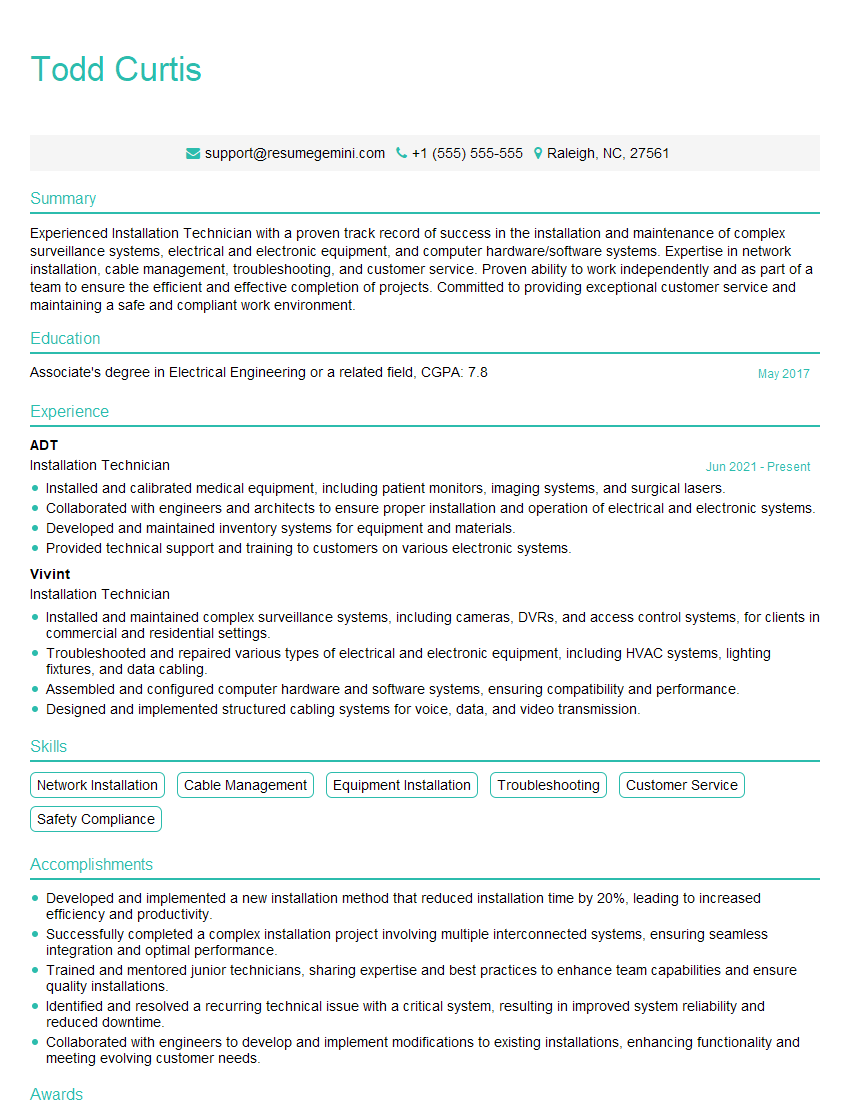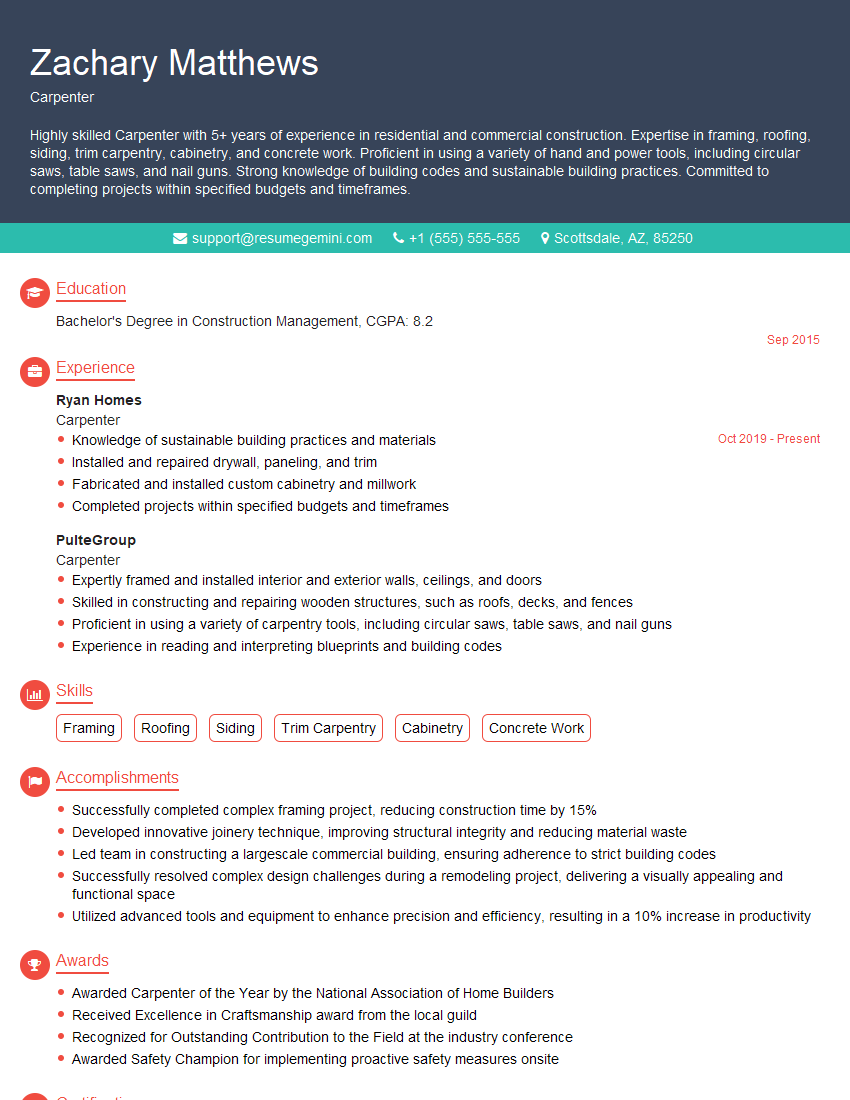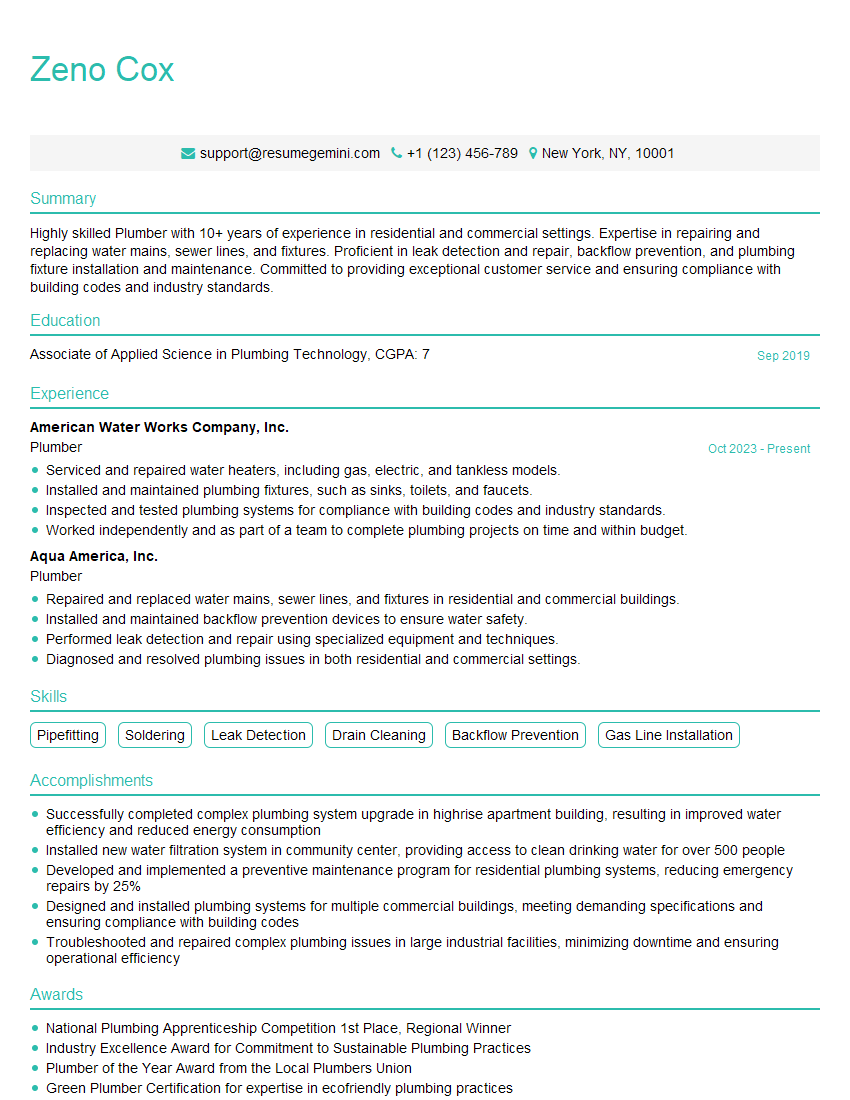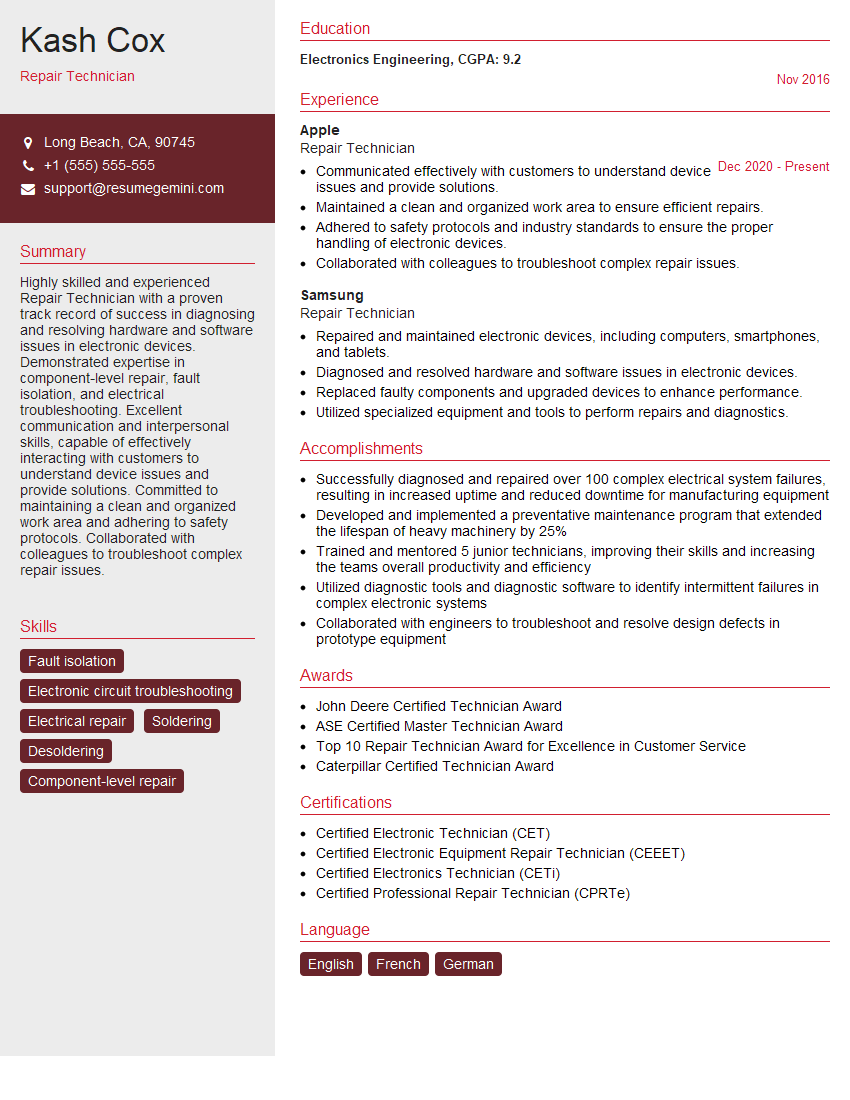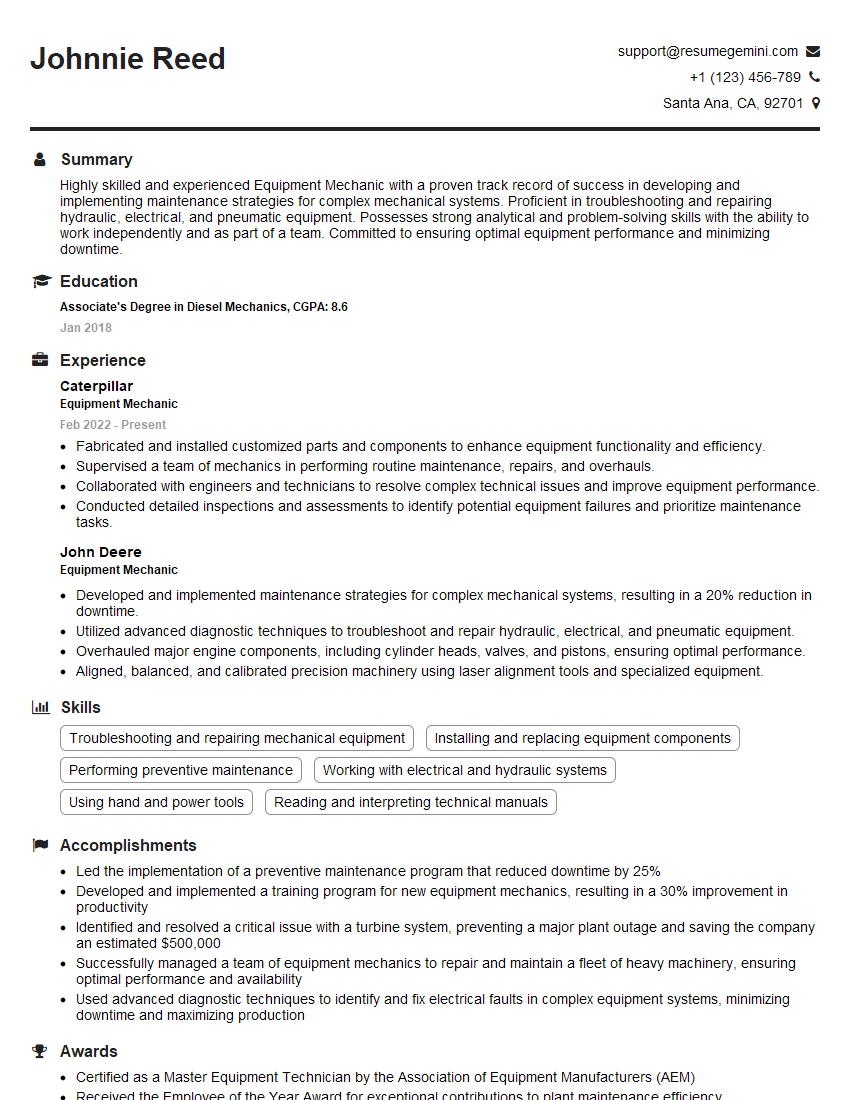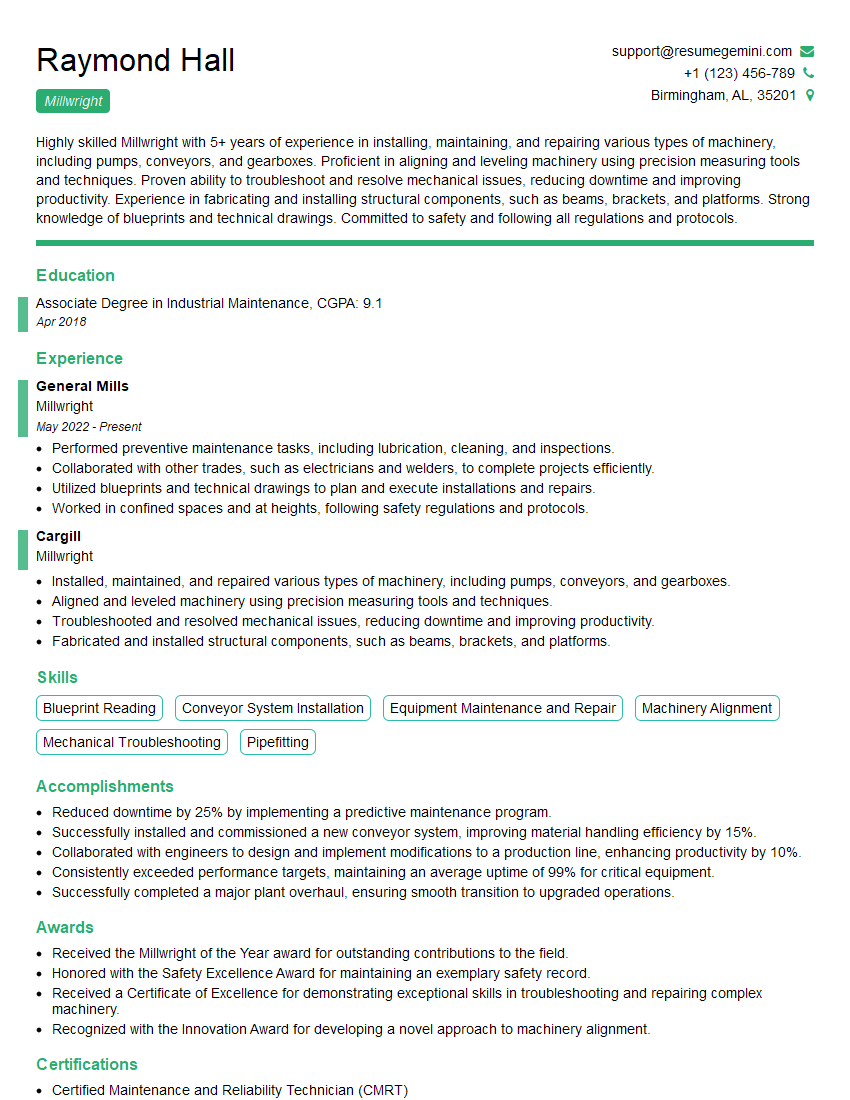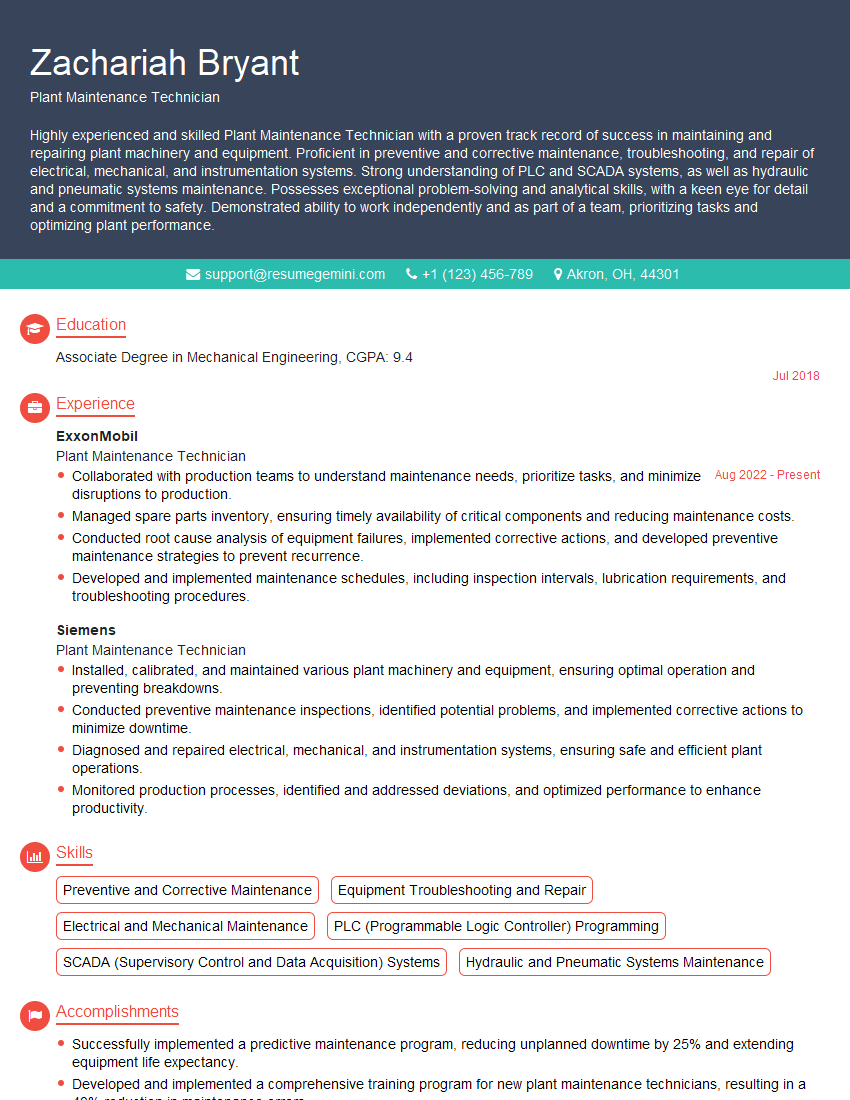Unlock your full potential by mastering the most common General Tool Proficiency interview questions. This blog offers a deep dive into the critical topics, ensuring you’re not only prepared to answer but to excel. With these insights, you’ll approach your interview with clarity and confidence.
Questions Asked in General Tool Proficiency Interview
Q 1. What safety precautions do you take when using power tools?
Safety is paramount when using power tools. My approach is based on a layered safety system, starting with proper preparation and extending through to post-use procedures. This includes:
Personal Protective Equipment (PPE): Always wear appropriate safety glasses, hearing protection, and a dust mask, depending on the task. For tasks involving rotating parts, I always use work gloves and appropriate clothing to avoid entanglement.
Tool Inspection: Before each use, I thoroughly inspect the tool for damage, loose parts, or frayed cords. A damaged tool is a dangerous tool and should be immediately taken out of service.
Work Area Safety: I ensure the work area is well-lit, clutter-free, and provides sufficient space to work safely. This includes securing the workpiece to prevent movement during operation.
Secure Grip: I maintain a firm grip on the tool at all times, ensuring I have good control and balance. This helps prevent kickbacks or loss of control.
Proper Technique: I use the correct techniques for each tool and operation, following manufacturer’s instructions carefully. This includes understanding the tool’s limitations and avoiding overexertion.
Disconnecting Power: Always unplug the tool before making adjustments, changing bits, or cleaning. Never leave a running power tool unattended.
For example, while using a circular saw, I always use a push stick to keep my hands safely away from the blade. I also always ensure the blade guard is properly functioning and securely in place. A single lapse in safety can lead to serious injury, therefore careful preparation and constant vigilance are crucial.
Q 2. Describe your experience with hand tools such as hammers, screwdrivers, and wrenches.
I’ve extensive experience with a wide range of hand tools, starting from my early days building model airplanes. My proficiency extends to using hammers for various tasks, from driving nails into wood to gently tapping components into place. I understand the importance of using the correct hammer size and weight for the job. Using a sledgehammer to drive small finishing nails would be disastrous!
Screwdrivers are another fundamental tool, and I’m skilled in using both Phillips and flathead screwdrivers, selecting the appropriate size and type for each screw. I understand the importance of applying the right amount of pressure to avoid stripping the screw head. Over-tightening can damage the screw and the surrounding material.
Wrenches are used regularly, and my experience includes using various types, including open-end, box-end, and adjustable wrenches. I understand the critical importance of selecting the correct size to avoid rounding off bolt heads or damaging the fastener. I also recognize when to use a ratchet wrench to improve efficiency.
My experience is not just about using these tools; it’s about understanding their nuances, choosing the right tool for the task, and using them safely and effectively.
Q 3. How do you identify different types of fasteners (screws, bolts, rivets)?
Identifying different fasteners requires careful observation of their physical characteristics. Here’s how I distinguish between screws, bolts, and rivets:
Screws: These are typically self-tapping, meaning they create their own threads as they are driven into the material. They have a tapered point and threads that run almost to the head. Screws come in various head styles (Phillips, slotted, hex) and materials (wood screws, machine screws).
Bolts: Bolts require a pre-existing hole and typically have a threaded shank with a head on one end and often a nut on the other. They are typically used to join two or more pieces securely. They come in various materials and head styles (hex, carriage, button).
Rivets: Rivets are permanent fasteners. They are inserted through holes in the joined materials and then deformed (usually by hammering or using a special tool) to create a strong, permanent joint. They are often chosen for applications where disassembly isn’t required.
For example, I’d easily differentiate a wood screw from a bolt by noticing the tapered point of the screw versus the typically blunt or slightly rounded end of a bolt. The presence of a nut further confirms it’s a bolt.
Q 4. Explain the proper use and maintenance of a measuring tape.
A measuring tape is a simple but essential tool, requiring careful handling and maintenance to ensure accuracy. Proper use involves:
Hook Placement: The hook at the end of the tape is designed to account for the thickness of the hook itself. To accurately measure from the end of a surface, ensure the hook is placed at the starting point.
Reading the Scale: Carefully read the scale, ensuring you correctly identify the inches, feet, and fractional markings. Double-check your readings, particularly for important measurements.
Proper Extension: Extend the tape slowly and smoothly, avoiding jerky movements that could damage the tape or cause inaccurate readings.
Maintaining Tension: Maintain a consistent tension while taking the measurement to prevent slack or over-stretching. This affects accuracy significantly.
Maintenance involves regularly checking the tape for kinks, damage to the blade, or a broken hook. Keeping the tape clean and free from debris extends its lifespan. A damaged tape measure is prone to error and must be replaced promptly.
Q 5. How would you troubleshoot a malfunctioning power drill?
Troubleshooting a malfunctioning power drill involves a systematic approach. First, I’d identify the symptom: is it not turning, running slowly, overheating, or something else? Here’s a potential troubleshooting process:
Check the Power Source: Ensure the power cord is securely connected to both the drill and the power outlet. Try a different outlet to rule out power issues.
Inspect the Chuck: Make sure the chuck is properly tightened and the drill bit is secure. A loose bit or chuck can prevent the drill from functioning correctly.
Check the Battery (for cordless drills): If it’s a cordless drill, check the battery charge level. A low battery can cause reduced power or complete failure. Try a fully charged battery.
Examine the Brushes (for brushed drills): In older brushed drills, worn-out brushes are a common cause of failure. These are relatively easy to replace.
Check for Obstructions: Look for any obstructions that might be hindering the drill’s operation. This might involve removing debris from the chuck or motor vents.
Assess the Gearbox: If the drill makes unusual noises or feels sluggish, there might be an issue with the gearbox. This usually requires professional repair.
If the problem persists after these checks, it might require professional repair or replacement.
Q 6. What are the different types of saws and their applications?
Saws are categorized by their blade type and cutting action. Common types include:
Circular Saw: A versatile saw with a rotating circular blade, ideal for straight cuts in wood, metal, and plastics. The depth of cut is adjustable, and it’s commonly used for rip cuts and crosscuts.
Jigsaw: Used for intricate curves and straight cuts in various materials. It utilizes a reciprocating blade and often has a variable speed control.
Hand Saw: A manual saw with a toothed blade, used for more precise cuts when power tools are unavailable or inappropriate.
Reciprocating Saw (Sawzall): A powerful saw with a reciprocating blade, excellent for demolition and rough cutting. It can cut through various materials, including metal, wood, and plastic.
Miter Saw: A saw designed for accurate angle cuts, often used in woodworking for creating joints. It uses a rotating blade and features adjustable miter angles.
Table Saw: A stationary power saw that uses a rotating blade to cut wood. It is ideal for accurate, repetitive cuts.
The choice of saw depends heavily on the material being cut, the required accuracy, and the complexity of the cut. For instance, a jigsaw is perfect for cutting curves in plywood, while a circular saw is best for straight cuts in dimensional lumber.
Q 7. Describe your experience with different types of pliers.
My experience encompasses a variety of pliers, each suited to different tasks. These include:
Slip-Joint Pliers: Adjustable pliers with a simple, versatile design. I often use them for gripping and bending wires or small components. They are adaptable to different sizes.
Needle-Nose Pliers: Long, thin jaws ideal for reaching into tight spaces and working on delicate components such as electronics. The precision makes them essential for detail work.
Lineman’s Pliers: Heavy-duty pliers with a cutting edge, used for cutting and gripping wire. They have a strong build for heavier work.
Locking Pliers (e.g., Vise-Grips): These pliers feature a locking mechanism, allowing for a secure grip on a workpiece without constant pressure. This is invaluable for holding parts while working on them.
Diagonal Cutters (Dykes): Pliers specifically designed for cutting wire. They are commonly used for cutting small-gauge wire cleanly.
The choice of pliers depends on the task at hand. For instance, while I would use needle-nose pliers for delicate electronics work, I’d opt for lineman’s pliers for heavier-duty tasks like cutting through thicker wire.
Q 8. How do you safely operate a circular saw?
Operating a circular saw safely requires a multi-faceted approach focusing on preparation, technique, and awareness. Think of it like driving a car – you wouldn’t get behind the wheel without understanding the controls and traffic laws. Similarly, before using a circular saw, you need to understand its mechanics and potential hazards.
Preparation is key: Always inspect the saw blade for damage, ensuring it’s sharp and securely mounted. A dull blade requires more force, increasing the risk of kickback. Check the saw’s power cord for any fraying or damage. Wear appropriate safety gear, including eye protection (safety glasses or a face shield), hearing protection (earplugs or muffs), and work gloves. Consider a dust mask depending on the material you’re cutting.
Secure your workpiece: Never freehand cut large pieces of wood. Use clamps or a workbench to secure the material firmly. This prevents the wood from moving unexpectedly, reducing the risk of injury. Think of it like anchoring a boat – you wouldn’t try to sail in rough waters without a secure mooring.
Proper technique: Maintain a firm grip on the saw, keeping both hands on the handles. Start the saw before making contact with the wood and allow the blade to reach full speed. Cut slowly and steadily, avoiding forcing the saw through the material. Always cut with the blade facing away from your body. Consider using a push stick for narrow cuts to keep your hands safely away from the blade.
Awareness of surroundings: Ensure the area around you is clear of obstacles and people. Be mindful of the saw’s kickback potential – if the blade binds, it can suddenly reverse direction. Never reach over a running saw blade.
Following these steps will significantly reduce the risk of accidents and ensure safe and efficient operation. Remember, safety is paramount!
Q 9. Explain the importance of using the correct size wrench for a given bolt.
Using the correct size wrench is crucial for both safety and efficiency. Using the wrong size can lead to stripped bolts, damaged threads, or even serious injury.
Stripped Bolts: A wrench that’s too small will round off the bolt head, rendering it useless and requiring more effort (and potentially damage) to remove. Think of trying to turn a screw with the wrong size screwdriver – it’s frustrating and ineffective.
Damaged Threads: A wrench that’s too large can damage the bolt’s threads, making it difficult or impossible to tighten or loosen the bolt. Over-tightening with the wrong size wrench can break the bolt entirely.
Injury: Using a wrench that’s too small can cause the wrench to slip, potentially leading to injury from the tool or the force impacting your hand.
Using the correct size wrench ensures a proper grip and prevents damage. The perfect fit allows for a secure connection, maximizing torque application while minimizing the risk of slippage. It’s about precision and control.
Q 10. How do you handle different types of wood and metal?
Handling different types of wood and metal requires understanding their properties and selecting the right tools for the job. Just like you wouldn’t use a butter knife to cut a steak, you need the right tools for each material.
Wood: Different wood types have varying hardness and grain patterns. Hardwoods like oak and maple require sharper tools and potentially slower cutting speeds than softwoods like pine. The grain direction significantly affects cutting – cutting with the grain is easier and cleaner than cutting against it. You might use different techniques such as ripping (cutting with the grain) and crosscutting (cutting against the grain), along with different blades depending on the wood.
Metal: Metals vary in hardness, ductility, and other properties. Steel, aluminum, and brass require different cutting and shaping techniques. For example, cutting steel often necessitates specialized blades and possibly coolants to prevent overheating and tool damage. You’ll also use different cutting techniques and tools such as hacksaws for steel and specialized tools for softer metals like aluminum.
Understanding the properties of each material is key to selecting the proper tools and techniques, ensuring a safe and efficient working process.
Q 11. What experience do you have with welding equipment?
I have extensive experience with various welding equipment, including MIG (Metal Inert Gas), TIG (Tungsten Inert Gas), and stick welding. My experience encompasses both ferrous and non-ferrous metals. I’m proficient in setting up and operating these machines, selecting the appropriate parameters (voltage, amperage, shielding gas) for different materials and thicknesses.
MIG Welding: I’m comfortable with various wire feeds and gas types, proficient in both short-circuit and spray transfer techniques. I’ve completed numerous projects involving MIG welding, from simple repairs to more complex fabrications.
TIG Welding: My TIG experience includes both AC and DC welding, with proficiency in precision welding of thin materials. I understand the importance of maintaining a clean and consistent weld pool.
Stick Welding: I’m familiar with various electrode types and their applications. I understand the importance of proper electrode angle and arc length for consistent welds.
Safety is a paramount concern in welding. I’m well-versed in safety procedures, including proper ventilation, eye and respiratory protection, and fire prevention measures.
Q 12. Describe your experience with pneumatic tools.
My experience with pneumatic tools spans a wide range, including impact wrenches, nail guns, air ratchets, and sanders. I understand the importance of maintaining air pressure, keeping the tools lubricated, and ensuring proper safety procedures are followed.
Impact Wrenches: I’m proficient in using impact wrenches for various applications, from loosening stubborn bolts to quickly tightening fasteners. I understand the importance of selecting the appropriate socket size and impact setting to prevent damage.
Nail Guns: I have experience with various types of nail guns, including framing nailers and finish nailers. I’m adept at selecting the correct nails and pressure settings for different materials and applications, always emphasizing safe handling procedures.
Air Ratchets and Sanders: These tools offer efficiency in specific tasks. Understanding air pressure, proper tool maintenance (lubrication and air filtration) are critical for optimal performance.
Pneumatic tools are powerful and efficient, but they also require careful handling. I always inspect the tools before use, check air hoses for damage, and use appropriate safety equipment.
Q 13. How do you maintain and clean your tools?
Maintaining and cleaning tools is crucial for their longevity and safe operation. Think of it like maintaining a car – regular maintenance prevents larger problems down the road.
Cleaning: After each use, I clean all tools thoroughly, removing debris, dust, and other contaminants. This prevents corrosion and ensures smooth operation. For example, I might use a wire brush to clean metal tools and compressed air to remove dust from pneumatic tools.
Lubrication: I lubricate moving parts of tools, such as hinges, joints, and sliding mechanisms, using appropriate lubricants. This reduces friction and wear, extending the tool’s lifespan. I would use specific greases for pneumatic tools and oils for mechanical parts.
Storage: I store tools in a clean, dry place, away from moisture and extreme temperatures. I organize tools properly to prevent damage and make them easy to find when needed. Well organized tools are safer tools.
Sharpening: For cutting tools, such as saws and chisels, regular sharpening is essential for optimal performance and safety. Dull tools are dangerous tools.
This routine maintenance ensures tools remain in peak condition, providing safe and efficient operation for years to come.
Q 14. What are some common causes of tool failure, and how do you prevent them?
Tool failure can stem from various causes, often preventable with proper care and usage.
Overuse/Overloading: Forcing a tool beyond its capabilities, using it for tasks it’s not designed for, or neglecting maintenance can lead to premature wear and tear, ultimately resulting in failure. Think of a small car trying to tow a large trailer – it’s not designed for that and will likely break down.
Improper Maintenance: Neglecting regular cleaning, lubrication, and sharpening can lead to corrosion, increased friction, and ultimately, tool failure. Rust and dirt are the enemies of good tools.
Incorrect Usage: Using a tool incorrectly, such as applying excessive force or using it at an improper angle, can cause damage and lead to failure. Following the manufacturer’s instructions is crucial.
Damaged Parts: A cracked handle, a bent shaft, or a damaged blade can compromise the tool’s integrity and lead to failure. Regular inspections are critical for early detection.
Preventing tool failure involves regular inspection, proper maintenance, appropriate use, and selecting the right tool for the job. A little prevention goes a long way towards ensuring tool longevity and safety.
Q 15. How familiar are you with using a level?
I’m highly proficient in using a level, both the traditional spirit level and digital versions. A level is a tool used to ensure a surface is perfectly horizontal or vertical. Understanding its proper use is crucial for various tasks, from hanging pictures to building structures. I’m familiar with different types, including torpedo levels (small and compact), box levels (for larger surfaces), and laser levels (for greater accuracy and range).
For instance, when hanging a shelf, I’d place the level on the surface where the shelf will be mounted, ensuring the bubble is centered within the vial. This indicates the shelf is perfectly level. If using a digital level, I’d check the digital readout to confirm the angle is 0° for horizontal or 90° for vertical.
Beyond simple leveling, I understand the importance of double-checking and using multiple points of reference to ensure accuracy, especially in larger projects. In carpentry, using a level is foundational to achieving straight walls and properly aligned structures.
Career Expert Tips:
- Ace those interviews! Prepare effectively by reviewing the Top 50 Most Common Interview Questions on ResumeGemini.
- Navigate your job search with confidence! Explore a wide range of Career Tips on ResumeGemini. Learn about common challenges and recommendations to overcome them.
- Craft the perfect resume! Master the Art of Resume Writing with ResumeGemini’s guide. Showcase your unique qualifications and achievements effectively.
- Don’t miss out on holiday savings! Build your dream resume with ResumeGemini’s ATS optimized templates.
Q 16. How do you measure angles accurately?
Accurate angle measurement is essential in many trades. I use a combination of tools depending on the required precision and the project’s scale. For simpler tasks, a protractor might suffice. However, for more precise measurements, I frequently use an angle finder or digital inclinometer. These instruments provide a more accurate reading, often to a fraction of a degree.
For example, when installing roof trusses, a precise angle measurement is critical for proper fit and structural integrity. I would use a digital inclinometer to measure the angle of the roof rafter, comparing it to the blueprint specifications to ensure accuracy. In other applications, like miter cuts in woodworking, the accuracy of the angle ensures a seamless join. To ensure accuracy I always double check readings and repeat the process to eliminate errors.
Understanding trigonometric functions (sine, cosine, tangent) is also helpful in certain situations, allowing me to calculate angles indirectly if direct measurement isn’t feasible.
Q 17. What safety measures do you employ when working at heights?
Safety is my paramount concern when working at heights. It starts with proper planning and risk assessment. This includes identifying potential hazards, such as unstable surfaces, overhead obstructions, and weather conditions.
- Proper Fall Protection: I always utilize appropriate fall protection equipment, such as harnesses, lanyards, and anchor points, and ensure they are correctly inspected and certified. I never rely on makeshift solutions.
- Scaffolding and Ladders: When using scaffolding or ladders, I ensure they are stable, properly secured, and rated for the weight capacity required. I always maintain three points of contact when climbing.
- Tools and Equipment: I secure tools and materials to prevent them from falling, and I use appropriate equipment for the task, ensuring everything is in good working order.
- Weather Considerations: I postpone work at heights in inclement weather conditions such as high winds or rain.
- Spotter/Teamwork: Whenever possible, I work with a spotter or team member for added safety, particularly on complex tasks. Communication is crucial in these scenarios.
I am also always up-to-date with the latest safety regulations and best practices. My commitment to safety goes beyond simply following rules; it’s about developing a proactive safety mindset.
Q 18. Describe your experience with working with various materials (wood, metal, plastic).
My experience spans a wide range of materials, including wood, metal, and plastic. Each material requires unique handling and processing techniques.
- Wood: I am comfortable with various woodworking techniques, including sawing, planing, shaping, and joining. My experience includes working with hardwoods, softwoods, and engineered wood products. Understanding wood grain and its impact on cutting and finishing is critical.
- Metal: I’m proficient in working with various metals, including steel, aluminum, and brass. This encompasses skills in cutting, shaping, welding (MIG, TIG), and drilling. I’m knowledgeable about safety precautions when working with metal, including proper ventilation and eye protection.
- Plastic: I have experience working with plastics, including cutting, shaping, and joining. I understand the properties of different types of plastics and select appropriate tools and techniques for the specific material.
I’m also familiar with using adhesives and fasteners appropriate for each material type, ensuring strong and durable results. For example, using wood glue for wood, epoxy for metal, and specialized adhesives for plastics.
Q 19. How do you diagnose and repair common household appliance problems?
Diagnosing and repairing household appliance problems requires a methodical approach. It often starts with careful observation and listening. I start by identifying the symptoms – what is the appliance NOT doing correctly? Is there a smell, unusual sound, or visual indicator?
Once the problem is identified, I usually consult a service manual or online resources specific to the model. Safety is paramount; I always disconnect the power before attempting any repairs. For instance, a refrigerator not cooling might indicate a faulty compressor, thermostat, or refrigerant leak. I’d methodically check these components, using a multimeter to measure voltage and continuity as necessary.
I’ve successfully repaired various appliances, including refrigerators, washing machines, dryers, and dishwashers. However, I also recognize my limitations. If I’m unable to diagnose or repair a problem safely, I always recommend contacting a qualified professional.
Q 20. Explain your understanding of torque and its importance in fastening.
Torque is the rotational force applied to tighten or loosen a fastener. It’s crucial because applying the correct amount prevents damage to the fastener or the material it’s securing. Too little torque leads to loose connections and potential failure; too much can strip threads or break the fastener.
Torque is measured in pound-feet (lb-ft) or Newton-meters (Nm). I use a torque wrench, which allows me to precisely control the amount of torque applied. Different fasteners and materials require different torque specifications; these are usually found in manufacturer’s instructions or engineering specifications. For example, when assembling critical components like engine parts, using the wrong torque can lead to serious issues. The torque wrench ensures the right amount of tightening force, preventing damage to threads and preventing leaks.
Understanding the importance of torque is essential for ensuring the safety and reliability of any assembly. A improperly tightened bolt could mean the difference between a functioning item and a failure.
Q 21. Describe your experience with using a multimeter.
A multimeter is a versatile tool used to measure electrical properties like voltage, current, and resistance. I’m highly experienced in using multimeters for various tasks, from troubleshooting electrical circuits to testing components.
I know how to select the appropriate settings on the multimeter depending on the measurement being taken. For example, to measure the voltage of a battery, I’d set the multimeter to the DC voltage setting and place the probes across the battery terminals. Similarly, to measure the resistance of a resistor, I’d use the ohms setting. I understand the importance of safety precautions when using a multimeter, including avoiding contact with live circuits. A mis-use of this tool can cause serious injury.
Multimeters are essential for diagnosing electrical problems in appliances and circuits. I’ve used them extensively to identify faulty components, shorted wires, and other electrical issues, leading to effective repairs. Their ability to check continuity is invaluable in tracking down broken wires or connections.
Q 22. How do you interpret technical drawings and schematics?
Interpreting technical drawings and schematics is fundamental to any skilled tradesperson. It involves understanding the visual language used to represent three-dimensional objects on a two-dimensional plane. This includes recognizing various symbols, lines, and dimensions to visualize the final product or process. I approach this by first identifying the drawing’s type (e.g., orthographic projection, isometric view), then carefully examining the views to understand the object’s form and dimensions. I look for details like tolerances, material specifications, and assembly instructions. For instance, a detailed mechanical drawing might show multiple views (front, side, top) to accurately represent the piece’s shape. I then use these views to mentally assemble the components in my mind and anticipate potential assembly challenges. I’m comfortable using various measurement scales and converting units as needed.
For example, when working on a cabinetry project, I rely on detailed drawings showing each piece’s dimensions, wood type, and joinery methods. I meticulously check measurements and compare them to the actual materials to ensure a precise fit. I also ensure I understand the order of assembly based on the provided schematics and use these drawings as my guide throughout the process.
Q 23. What is your experience with preventative maintenance?
Preventative maintenance is crucial for maximizing tool lifespan and ensuring workplace safety. My experience encompasses a systematic approach, involving regular inspections, cleaning, lubrication, and minor repairs. This includes visually inspecting tools for damage, checking for loose parts or excessive wear and tear, and ensuring that safety mechanisms (such as guards) are functioning correctly. I maintain detailed logs documenting the maintenance performed, including dates, tasks completed, and any parts replaced. This documentation helps track tool performance and predict potential future issues.
For instance, I regularly clean and lubricate my power tools to prevent rust and ensure smooth operation. I also check the sharpness of blades and bits, replacing them when necessary to maintain accuracy and efficiency. I’m familiar with the specific maintenance requirements for various types of tools – from simple hand tools to complex machinery, tailoring my approach to the tool’s specific needs and design.
Q 24. What experience do you have using a variety of cutting tools (e.g., chisels, knives)?
I have extensive experience with a wide array of cutting tools, including chisels, knives (various types: utility, paring, etc.), and specialized woodworking tools. My proficiency extends to understanding the different materials these tools are suited for and the proper techniques for safe and efficient cutting. I understand the importance of selecting the right tool for the job, considering factors like material hardness, desired cut shape, and the overall project requirements. I also understand the importance of maintaining a sharp edge on my cutting tools, using sharpening stones and honing guides to maximize precision and safety. A dull tool can lead to slips and accidents. Therefore, I frequently assess and maintain the sharpness of my tools.
For example, when working with hardwoods, I would choose a sturdy chisel and utilize a mallet for more control and force. When working with softer materials like balsa wood, I’d use a sharp utility knife for precise and clean cuts. I’m also adept at using specialized cutting tools for various tasks like mortise and tenon joinery or dovetail cuts.
Q 25. How do you identify and address potential safety hazards in a workshop?
Identifying and addressing safety hazards is paramount in any workshop environment. My approach involves a proactive and systematic inspection of the workspace, looking for potential dangers. This includes checking for proper lighting, identifying potential trip hazards (like cords or debris), ensuring that all tools are stored correctly and are in good working order, and verifying that personal protective equipment (PPE) is readily available and used appropriately. I also pay close attention to electrical safety, checking for frayed cords and ensuring proper grounding. I’m familiar with various safety regulations and best practices, ensuring a safe work environment.
For example, I always clear away any clutter before starting a task. If working with power tools, I ensure that safety guards are properly installed and in working order. I also educate myself and others on the specific hazards associated with the tools and materials being used. This includes understanding the appropriate ways to handle and dispose of hazardous materials.
Q 26. How proficient are you in using a drill press?
I am highly proficient in using a drill press. This involves not only knowing how to operate the machine safely but also understanding the nuances of drilling different materials and using various drill bits effectively. My skills encompass selecting the correct speed and feed rate for various materials and drill bit sizes. I’m adept at using various drill bits – from standard twist drills to specialized bits for wood, metal, or plastic. I understand the importance of using a vise or clamping mechanism to securely hold the workpiece, ensuring accuracy and safety. I understand the importance of keeping the drill press clean and well-maintained to prevent accidents and ensure optimal performance.
For example, when drilling through hardwoods, I’d use a lower speed and a sharper bit to prevent tearing or chipping. For softer metals, I’d use cutting fluid to prevent heat buildup and improve the quality of the hole. I also carefully assess the workpiece’s thickness and choose the appropriate bit length to prevent breakage.
Q 27. Describe your experience with using a lathe or milling machine (if applicable).
While I haven’t had extensive experience operating a lathe or milling machine in a professional capacity, my understanding of their operation and safety procedures is robust. I’ve completed training courses that covered the principles of operation, setting up the machines, selecting appropriate tooling, and understanding the crucial safety protocols. I understand the concepts of machining, such as turning, milling, and boring, and I can interpret machining drawings. I am comfortable working with the basic controls and settings, and I recognize that operating these machines requires a high degree of skill and caution. Safety is paramount, and I’d always prioritize training and supervision when working with these powerful tools.
I believe continued training and hands-on practice will increase my proficiency. I’m keen to learn more about these sophisticated tools and integrate them into my skillset for increased versatility.
Q 28. How do you ensure accuracy when performing precision tasks?
Ensuring accuracy in precision tasks relies on a combination of factors, including proper planning, using appropriate tools, and meticulous execution. My approach involves understanding the project’s tolerances and the tools’ capabilities. I meticulously measure and mark workpieces, utilizing precise measuring instruments (e.g., calipers, micrometers). I verify measurements multiple times before undertaking a critical step. I also pay close attention to the details, understanding how factors like temperature and material properties can affect accuracy. I constantly check my work against the plans and make any necessary adjustments throughout the process.
For instance, when building a complex piece of furniture, I’d use precision measuring tools to ensure that all joints are perfectly aligned. I’d also use jigs and fixtures to maintain consistency and repeatability. Regular checks throughout the assembly process help prevent accumulating errors and ensure a high-quality final product. I approach every task with a mindset of thoroughness and double-checking.
Key Topics to Learn for General Tool Proficiency Interview
- Hand Tool Safety and Usage: Understanding proper techniques for handling hammers, screwdrivers, wrenches, pliers, and other common hand tools. This includes recognizing potential hazards and employing safe work practices.
- Power Tool Operation and Maintenance: Safe and effective operation of drills, saws, sanders, and other power tools. This includes understanding different types of power tools, their applications, and routine maintenance procedures.
- Measuring and Marking Techniques: Accurate use of measuring tapes, rulers, levels, and squares for precise measurements and marking on materials. This includes understanding different units of measurement and tolerances.
- Material Selection and Properties: Knowledge of common construction materials (wood, metal, plastic) and their properties. Understanding which materials are best suited for specific tasks and projects.
- Basic Construction and Repair Techniques: Familiarity with fundamental construction and repair processes, such as assembling, fastening, and finishing. This includes understanding different joining methods and techniques.
- Problem-Solving and Troubleshooting: Ability to identify and troubleshoot common problems encountered during tool use and construction tasks. This involves critical thinking and practical problem-solving skills.
- Workplace Safety Regulations and Procedures: Understanding and adhering to relevant safety regulations and procedures related to tool use and general workshop practices.
Next Steps
Mastering General Tool Proficiency is crucial for career advancement in numerous fields, opening doors to higher-paying roles and increased responsibility. A strong understanding of these skills demonstrates your practical abilities and commitment to safety. To significantly boost your job prospects, create an ATS-friendly resume that highlights your skills effectively. ResumeGemini is a trusted resource to help you build a professional and impactful resume. We provide examples of resumes tailored to General Tool Proficiency to guide you in showcasing your expertise. Invest time in crafting a compelling resume—it’s your first impression with potential employers.
Explore more articles
Users Rating of Our Blogs
Share Your Experience
We value your feedback! Please rate our content and share your thoughts (optional).
What Readers Say About Our Blog
Hello,
We found issues with your domain’s email setup that may be sending your messages to spam or blocking them completely. InboxShield Mini shows you how to fix it in minutes — no tech skills required.
Scan your domain now for details: https://inboxshield-mini.com/
— Adam @ InboxShield Mini
Reply STOP to unsubscribe
Hi, are you owner of interviewgemini.com? What if I told you I could help you find extra time in your schedule, reconnect with leads you didn’t even realize you missed, and bring in more “I want to work with you” conversations, without increasing your ad spend or hiring a full-time employee?
All with a flexible, budget-friendly service that could easily pay for itself. Sounds good?
Would it be nice to jump on a quick 10-minute call so I can show you exactly how we make this work?
Best,
Hapei
Marketing Director
Hey, I know you’re the owner of interviewgemini.com. I’ll be quick.
Fundraising for your business is tough and time-consuming. We make it easier by guaranteeing two private investor meetings each month, for six months. No demos, no pitch events – just direct introductions to active investors matched to your startup.
If youR17;re raising, this could help you build real momentum. Want me to send more info?
Hi, I represent an SEO company that specialises in getting you AI citations and higher rankings on Google. I’d like to offer you a 100% free SEO audit for your website. Would you be interested?
Hi, I represent an SEO company that specialises in getting you AI citations and higher rankings on Google. I’d like to offer you a 100% free SEO audit for your website. Would you be interested?
good


